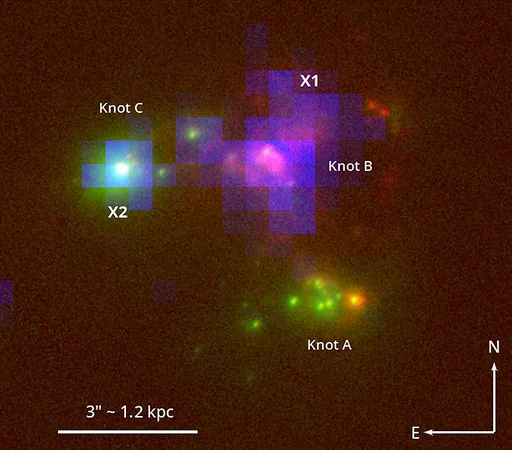
Unlocking the Secrets of the Universe: Galactic Superwinds and Lyman Continuum Leakage
2025-04-11
Author: Jia
Discovering Haro 11: A Cosmic Hotspot
A groundbreaking study has put the spotlight on the nearby starburst galaxy Haro 11, revealing how fierce superwinds may play a crucial role in allowing galaxies to expel ionizing radiation. This phenomenon is believed to have significantly influenced cosmic reionization in the universe’s early years.
Diving into X-ray Mysteries
Published in Astronomy & Astrophysics, this research leverages advanced X-ray data from NASA’s Chandra X-ray Observatory and the European Space Agency’s XMM-Newton to scrutinize Haro 11’s explosive X-ray activity. This galaxy is a rare Lyman continuum emitter that offers unique insights into ionizing radiation mechanisms.
Two X-ray Sources: A Tale of Two Energies
Within Haro 11 lies two notable X-ray sources, X1 and X2, linked to massive star-forming regions known as Knots B and C. While both sources produce ionizing Lyman continuum radiation, an intriguing twist emerges: X2, though fainter, leaks significantly more Lyman radiation than the higher-luminosity source, X1, which may be harboring an intermediate-mass black hole.
Uncovering Weighty Clues
A detailed analysis of X-ray spectra revealed that source X2 is shrouded by far less absorbing material—about ten times less than its counterpart. This suggests that X2 is less impeded by gas and dust due to powerful superwinds arising from vigorous star formation and supernova activity. These outflows likely carve paths through space, facilitating the escape of Lyman continuum photons.
The Superwind Connection
Employing a principal component analysis (PCA), the team examined the spectral variability in X1 and X2, unveiling distinct emission patterns indicative of hot, ionized gaseous outflows. These patterns resemble those found in other starburst-driven superwinds, such as the famed Cigar galaxy and Sculptor galaxy.
Connecting the Dots to Cosmic Reionization
The insights gathered provide a compelling hypothesis linking X-ray variability and starburst-driven outflows, potentially easing the leakage of ionizing radiation from galaxies like Haro 11. This research reinforces the theory that superwinds and stellar feedback are essential for creating routes through which ionizing photons can escape, unlocking vital links to cosmic reionization about a billion years after the Big Bang.
Local Galaxies, Global Implications
While high-redshift galaxies remain difficult to observe due to their distance and faintness, local counterparts like Haro 11 offer a revealing glimpse into these ancient cosmic events. This study underlines the pressing need for clearer X-ray observations to further discern the interactions between hot plasma, ionizing radiation, and the surrounding interstellar medium.
Meet the Researcher
The study is led by Ashkbiz Danehkar, an astrophysicist with a noteworthy background, including research on galactic outflows and stellar feedback. Funded by NASA grants at Eureka Scientific, Danehkar is poised to continue illuminating the mystery of our universe's evolution.

 Brasil (PT)
Brasil (PT)
 Canada (EN)
Canada (EN)
 Chile (ES)
Chile (ES)
 Česko (CS)
Česko (CS)
 대한민국 (KO)
대한민국 (KO)
 España (ES)
España (ES)
 France (FR)
France (FR)
 Hong Kong (EN)
Hong Kong (EN)
 Italia (IT)
Italia (IT)
 日本 (JA)
日本 (JA)
 Magyarország (HU)
Magyarország (HU)
 Norge (NO)
Norge (NO)
 Polska (PL)
Polska (PL)
 Schweiz (DE)
Schweiz (DE)
 Singapore (EN)
Singapore (EN)
 Sverige (SV)
Sverige (SV)
 Suomi (FI)
Suomi (FI)
 Türkiye (TR)
Türkiye (TR)
 الإمارات العربية المتحدة (AR)
الإمارات العربية المتحدة (AR)